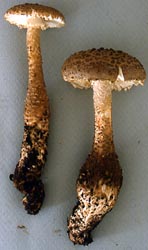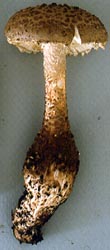|
[ Section Lepidella page. ]
[ Amanita Studies home. ]
[ Keys & Checklist/Picturebooks ] "Costa Rica Lepidella"
Technical description (t.b.d.) BRIEF DESCRIPTION: The cap of Amanita costaricensis is (43-) 50 - 120 (-145) mm wide, hemispherical to convex at first, becoming planar around the subumbonate center, tacky when moist, sometimes viscid over center, dull to satiny to subshiny, shiny in age, sometimes breaking in areola with warts on the center of the areola, with a nonstriate margin, except in age. The cap is brown to light brown with pinkish cast to pale grayish tan to yellowish cream to brownish-gray to mouse-gray, center becoming gray or dull dark brown. Volval remnants are present as patches or flakes or warts, gray to brownish-gray to brown, tending toward small scales toward margin, occasionally flat, pinkish patches, powdery, darkening with age. The flesh is white, usually with pale brownish gray to gray to brown region under the cap skin, sometimes pale ochraceous when exposed, 3 - 10.5 mm thick over the stem, thinning evenly to margin. The gills are free to narrowly adnate, close to crowded, white to pale cream in mass, off-white to very pale yellowish white in side view, relatively thick, frequently subventricose with gray edge. The short gills are truncate to rounded truncate to subattenuate to attenuate to attenuate in steps, plentiful, of diverse lengths, and unevenly distributed. The stem is 52 - 124 × 9 -18 (-22) mm, cylindric or narrowing upward, sometimes narrowing upward, varying from white to off-white to gray, smooth and undecorated above the ring, decorated with densely powdery to floccose or floccose-fibrillose volva below the ring. The ring is apical to superior, white becoming gray above, occasionally with a darker gray edge in age, below bearing gray powdery, striate above, skirt-like, submembranous to floccose-felted, tearing, often left as loose patches over the gills. The volva is absent or present as pyramidal warts or patches placed irregularly or subconcentrically arranged in few to many (up to 10 or more) rows at the broadest point of the bulb or extending as much as up to three-quarters of the bulb length, often with underlying flesh cracking to form white to pale grayish recurved scales with volval remnants on their tips, rather dark brownish gray, with limbus internus occasionally left as a thick, submembranous ring at the base of the stem. The bulb 30 - 57 (-112+) × 17 - 40 mm, turnip shaped to carrot shaped, rooting, either only slightly broader than stem or subabrupt. The flesh is white to dirty white, solid, infrequently with hollow portions. The odor is lacking or similar to nutmeg at first; in age, it has an "old ham"-type smell but more penetrating and unpleasant. The taste is not distinctive. The spores measure (7.5-) 8.5 - 13.2 (-16.0) × (5.1-) 6.0 - 8.5 (-12.6) µm and are ellipsoid to elongate, infrequently broadly ellipsoid or cylindric and amyloid. Clamps are present at base of basidia. Originally described from Costa Rica and Honduras. It is solitary to subgregarious in oak-magnolia forest or mixed oak forest. Amanita costaricensis is assignable to stirps Microlepis (see A. microlepis Bas). Within this stirps, it appears to be most closely related to Amanita onusta (Howe) Sacc., which is widely distributed in eastern North America. This species appears to be subject to the "yellowing syndrome", see A. subsolitaria (Murrill) Murrill. -- R. E. Tulloss Photos: R. E. Tulloss (Costa Rica)
[ Section Lepidella page. ]
[ Amanita Studies home. ]
[ Keys & Checklist/Picturebooks ] Last changed 1 October 2009. |



